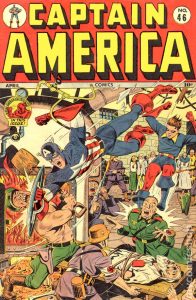It was probably in Cricket. Or maybe I saw it on 3-2-1-Contact! Or, heck, maybe it was a plain old school assignment. Anyway, sometime far Back in that very long conceptual Day, I encountered a Thing that involved telling a robot how to make you a sandwich. You’d write down the steps, and then the interrogation would begin:
Did you tell the robot how to unscrew the peanut butter jar? Or how to identify which jar contains peanut butter? Or where the knife is? Or how to open the silverware drawer? The point of the exercise was to demonstrate how easily you could screw up the seemingly simple task by leaving out essential steps. (And, possibly, to assuage the fears of any of us who might have been worrying about robots taking over the world. Clearly, they weren’t too bright. They had a ways to go.)
When I approach a comics script, I often have that robot in mind. Thinking of the robot helps me to avoid a mistake that’s very common for writers who are new to the comics format: including multiple actions in a single panel description.
But wait, I hear you say, there are, like, ten actions on this Captain America cover!

Fair enough. There’s certainly a lot going on. But each character is only performing a single action. It’s just as though Cap & Billy were caught in the middle of giving those Nazis what for by an intrepid photographer — Jimmy Olson, no doubt.
Seem obvious?
It may seem less so when you’ve started writing your script and you’ve got something like:
PANEL ONE
He puts the glass in the sink, goes downstairs to the garage, gets into the car and drives away.
It’s a perfectly reasonable (if inelegant) sentence. In comics, though? That is impossible to execute in a single image.
How about a panel for glass-in-the-sink, a panel on the stairs, a panel to open the car door, another to shut it, another to turn the key in the ignition, and you might want to have one with the garage door going up, unless he’s maybe so angry or drunk that he’s just gonna back the car right into it.
But here’s the cool thing: you don’t HAVE to include all of those images as panels. You could, for example, cut right from the glass to him in his car on the highway. Or you could slow it down farther. Maybe you want to show that it’s a struggle for him to make it down the stairs, so you split that up into multiple panels. Or maybe you move in closer to the glass itself, and something’s reflected in it that tells the reader why this guy is then going to get into his car.
What you can’t do is everything all at once.

Kevin Moore
March 6, 2010 at 11:35 pmNice post. One sentence can = four panels or thirty, depending on how much tension or drama or detail you want to put in. Okay, I’m not sure what a 30 panel sentence would look like, but I suspect Beckett wrote one much like it.
That Cpt America cover is awesome. Not in a “dude, that dude totally whacked that other dude” way. But in a “could there be more POW BIFF in one image?” way.
Sigrid Ellis
March 7, 2010 at 6:39 amIt was in Cricket, in one of the issues I still own. I’m not sure which one, though . . .
Sara
March 7, 2010 at 9:07 amOh cool! I don’t think my Crickets are still around, but I know my parents got my subscription started pretty early on, like maybe ’79 or ’80. Loved that magazine.
Dylan Meconis
March 7, 2010 at 12:34 pmThe multiple-actions thing is by far the most prevalent rookie mistake I’ve seen in comics scripts.
People seem to forget that comics aren’t movies; that’s part of why I try to avoid film-speak in my own scripts.
Saying “a zoom-in shot” or “we track with X as she goes down the hallway” leads to filmic thinking instead of juxtaposed still images. Movies are such a dominant form in the culture right now that they can really mess up other forms of narrative structure, and it irritates me!
Rich Johnston
March 16, 2010 at 8:49 amMy favourite was always
Panel One: The light on the answering machine blinks on and off.
Jane Irwin
March 18, 2010 at 6:05 amIt was definitely Cricket, because I read my issues to rags, and I remember that one well. I still have the giant box full of Cricket and National Geographic WORLD and Ranger Rick that I will someday donate to a school for kids to cut up. When I can bring myself to part with them, that is.